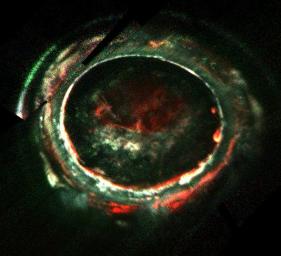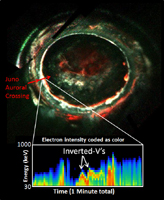
|
Jupiter’s Auroras Acceleration Processes
- Click the image above for a larger view
- Full-Res JPEG (534 x 487) (48.9 kB)
- Full-Res TIFF (534 x 487) (703.2 kB)
Caption:

Figure 1
Click on the image for larger annotated version
This image, created with data from Juno's Ultraviolet Imaging Spectrometer (UVS), marks the path of Juno's readings of Jupiter's auroras, highlighting the electron measurements that show the discovery of the so-called discrete auroral acceleration processes indicated by the "inverted Vs" in the lower panel (Figure 1). This signature points to powerful magnetic-field-aligned electric potentials that accelerate electrons toward the atmosphere to energies that are far greater than what drive the most intense aurora at Earth. Scientists are looking into why the same processes are not the main factor in Jupiter's most powerful auroras.
Background Info:
More information about Juno is online at http://www.nasa.gov/juno and http://missionjuno.swri.edu .
NASA's Jet Propulsion Laboratory manages the Juno mission for the principal investigator, Scott Bolton, of Southwest Research Institute in San Antonio. Juno is part of NASA's New Frontiers Program, which is managed at NASA's Marshall Space Flight Center in Huntsville, Alabama, for NASA's Science Mission Directorate. Lockheed Martin Space Systems, Denver, built the spacecraft. Caltech in Pasadena, California, manages JPL for NASA.
Cataloging Keywords:
| Name | Value | Additional Values |
|---|---|---|
| Target | Jupiter | |
| System | Jupiter | |
| Target Type | Planet | |
| Mission | Juno | |
| Instrument Host | Juno | |
| Host Type | Orbiter | |
| Instrument | ||
| Detector | ||
| Extra Keywords | Atmosphere, Color, Magnetosphere, Ultraviolet | |
| Acquisition Date | ||
| Release Date | 2017-09-06 | |
| Date in Caption | ||
| Image Credit | NASA/JPL-Caltech/SwRI | |
| Source | photojournal.jpl.nasa.gov/catalog/PIA21937 | |
| Identifier | PIA21937 | |
